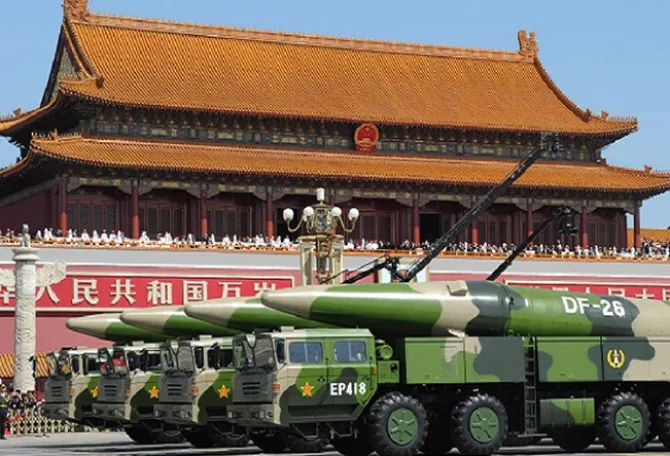
China’s nuclear strategy has remained relatively constant over the past few decades, but its nuclear arsenal appears to have been expanding rapidly in the past few years. Beijing is also continuously modernising and diversifying its nuclear delivery systems. China’s 2006 Defence White Paper provides the most authoritative description of Beijing’s nuclear strategy. The document states that China pursues a “self-defensive nuclear strategy.” Its traditional nuclear strategy is premised on a limited nuclear arsenal for assured retaliation and a no-first-use policy. However, the recent changes, especially in four verticals—quantity, quality, diversity and operations patterns—raise questions about China’s changing nuclear strategy.
China is also expanding its Rocket Force brigades. Between 2017 and 2019, China added over 10 new missile brigades—this is an unprecedented expansion from 29 to 39 brigades in only three years.
First, there is a quantitative change in China’s nuclear capabilities. In 2020, the United States (US) Department of Defence China Military Power report estimated that the People’s Republic of China (PRC) had around 200 nuclear warheads in its arsenal. However, the latest 2022 China Military Power report highlights that the PRC’s nuclear arsenal likely exceeds 400 operational nuclear warheads—a level that would not have been attained for a decade, according to the Pentagon’s previous estimate. Furthermore, the Pentagon projected that at this pace, China would have around 1,000 warheads by 2031 and 1,500 by 2035—on par with 1,550 warheads allowed to the US and Russia under the 2010 New Strategic Arms Reduction Treaty (New START Treaty). Furthermore, China is also expanding its Rocket Force brigades. Between 2017 and 2019, China added over 10 new missile brigades—this is an unprecedented expansion from 29 to 39 brigades in only three years. Currently, China has over 40 operational PLA RF brigades. It has recently constructed around 350 to 400 solid-fuel missile silos at Yumen, Hami, Hanggin Banner, and Jilantai. Previously, China only operated 20 missile silos for several decades for its DF-5 liquid-fuelled intercontinental ballistic missile (ICBM). The growing construction of silos indicates changes in China’s operational posture and practices. For instance, it is noted that the 14 silos at Jilantai are reserved explicitly for training and developing newer concepts of operations. Table 1: Estimated global nuclear warheads inventories
| Country |
Number of Active Nuclear Warheads |
Explanation |
| Russia |
5,889 |
1674 Deployed + 2815 Reserved +1400 Retired |
| United States |
5,244 |
1670 Deployed + 100 Deployed Nonstrategic + 1938 Reserved + 1536 Retired |
| China |
400-410 |
N/A |
| France |
290 |
N/A |
| United Kingdom |
225 |
N/A |
| Pakistan |
170 |
N/A |
| India |
164 |
N/A |
| Israel |
90 |
N/A |
| North Korea |
30 |
N/A |
| Total Inventory |
12,512 |
|
Source: Hans M. Kristensen, Matt Korda and Eliana Reynolds, Federation of American Scientists, 2023. Second, China is also improving the quality of its nuclear delivery systems. Over the past few years, China has worked on the accuracy and survivability of its nuclear arsenal. For instance, China’s latest long-range intercontinental ballistic missile (ICBM), the solid-fuelled Dongfeng (DF)-41, reportedly has a circular error probability of 100 meters. Furthermore, its dual-capable “hot-swappable” theatre-ranged delivery system, the DF-26 intermediate-range ballistic missile, is more accurate than the older version of the DF-21 missile. On the survivability issue, China’s rapid expansion of a silo-based ICBM force highlights its attempt to move towards a launch-on-warning (LOW) nuclear posture. LOW refers to a launch at an adversary on detecting an incoming missile before the adversary’s missile hits the target. As China’s nuclear strategy scholar, Fiona Cunningham, highlights this reflects Chinese concerns about the disadvantages of land-based mobile nuclear forces, whether their survivability, mobility, communications, or cost. The PRC is also working on multiple independently targetable re-entry vehicles (MIRV), and the latest 2022 China Military Power report highlights that China’s DF-5B ICBM can carry five MIRVs. Table 2: China’s Nuclear-Capable Missile Inventory
| Name |
Class |
Range (in km) |
| DF-41 |
ICBM |
13,000-15,000 |
| DF-5 |
ICBM |
13,000 |
| JL-3 |
SLBM |
Unknown |
| JL-2 |
SLBM |
8,000-9,000 |
| DF-31 |
ICBM |
7,000-11,700 |
| DF-4 |
ICBM/IRBM |
4,500-5,500 |
| DF-26 |
IRBM |
4,000 |
| DF-21 |
MRBM |
2,150 |
| DF-17 |
HGV |
1,800-2,500 |
| DF-16 |
SRBM |
800-1,000 |
| DF-15 |
SRBM |
600 |
| DF-11 |
SRBM |
280-300 |
| DF-12 |
SRBM |
280 |
| CJ-10 |
Cruise |
2,000 |
Sources: Missile Defence Project, “Missiles of China,” Missile Threat, Centre for Strategic and International Studies, April 12, 2021. China, Missile Defence Advocacy Alliance, January 2023. Third, along with the quantity and quality, China is diversifying its nuclear delivery system. It is advancing its nuclear triad consisting of land-based, sea-based and air-based nuclear delivery systems. The most reliable element of the Chinese nuclear force is the land-based, road-mobile, MIRV-capable DF-41 with an operational range of 15,000 km. However, China’s Type 094 nuclear-powered ballistic missile submarines (SSBNs), also known as boomers, are considered the most essential tool of their tactical deterrence. It is reported that China has around five to six operational Jin-class SSBNs armed with JL-2 and possibly JL-3 submarine launch ballistic missiles (SLBMs), capable of reaching the US. Furthermore, Stockholm International Peace Research Institute’s latest report highlights that Chinese H-6 bombers, which can deliver nuclear weapons, are now considered fully operational. The PRC is also developing a new nuclear-capable subsonic strategic stealth bomber, Xian H-20, and an air-launched ballistic missile, both of which could enter service in the next couple of years. These developments have brought the PRC to the cusp of a credible nuclear triad for the first time.
The most reliable element of the Chinese nuclear force is the land-based, road-mobile, MIRV-capable DF-41 with an operational range of 15,000 km.
Finally, the PRC is also developing newer operational patterns and concepts. With the recent infrastructure changes, the PLARF will likely begin storing nuclear warheads close to its launch brigades or silos. Historically, Base 67 (formerly Base 22), situated deep in the Qinling [秦岭] mountain range, is responsible for maintaining China’s nuclear warheads. But Chinese security experts David Logan and Phillip Saunders, in their latest research, highlighted that the Rocket Force’s nuclear-warhead handling regiments, which used to be under the jurisdiction of missile bases, are now under the command of the central warhead depot. This means there is an intent to move towards a centralised control system by distributed warhead handling practices. With this background, China may posture their silo forces to be on higher alert to enable a LOW capability, with missiles prepped to launch with live warheads on a rotating basis. Table 3: PLA RF Bases
| Base Number |
Nature of Work |
City |
| Base 61 |
Operations |
Huangshan |
| Base 62 |
Operations |
Kunming |
| Base 63 |
Operations |
Huaihua |
| Base 64 |
Operations |
Lanzhou |
| Base 65 |
Operations |
Shenyang |
| Base 66 |
Operations |
Luoyang |
| Base 67 |
Warhead Stockpile |
Baoji |
| Base 68 |
Engineering |
Luoyang |
| Base 69 |
Test and Training |
Yinchuan |
Source: Ma Xiu, PLA Rocket Force Organization, China Aerospace Studies Institute. Besides these developments, China is also working on developing support infrastructure like early warning remote sensing satellites and advanced ground-based radars. It has also recently tested its new hypersonic glide vehicle, possibly with a fractional orbital bombardment system. Some conclusive evidence highlights that China’s approach to its nuclear strategy is evolving. It is extremely important to understand the drivers of these changes. David Logan and Phillip C. Saunders’ recent publication insightfully attempts to discern these factors. More such contributions from scholars from different regions of the world would help provide a nuanced understanding of the growing discrepancy between the PRC’s declaratory nuclear policy and advancing nuclear capabilities.
Suyash Desai is a research scholar studying China’s defence and foreign policies.
The views expressed above belong to the author(s). ORF research and analyses now available on Telegram! Click here to access our curated content — blogs, longforms and interviews.




 PREV
PREV


